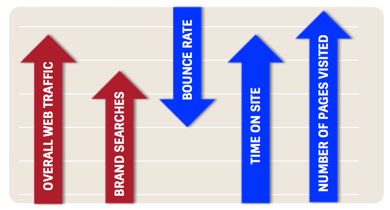If you haven’t already, please read How Google Set Standards That Other Online Advertising Channels Can’t Live Up To, before proceeding. This article is really a follow up to that one.
Okay, you’re back (or still here because you’ve already read that one) so… if we can’t measure digital advertising based on the click, then what? In the article I mention increased store traffic, increased phone calls and increased sales. But come on, it’s 2014. Surely there are some better ways of measuring the success of a digital campaign than what they used in 1971! Right?
“Isn’t that why I get all these reports, David? My social media manager is telling me we have a hundred new LIKES and my newspaper guy says I’ve got a .15 click through rate on the display campaign we are running on his dot-com, and that I should be excited about that. But I don’t know that any of that means the campaign is working!”
I feel your pain. I’ve been the guy telling you that your CTR is great and that you’ve got to trust that the campaign is working. But ultimately, no social media manager, no “internet marketing guy” – even one you trust, can tell you for sure that your advertising is working. ONLY YOU can know if you’re getting leads, if you’re making sales, if you’re getting value for your investment.
We can educate you on the statistics that indicate that things are working, but ultimately, you should take on some of that burden with how you measure your web traffic, and that’s what this article is about.
 Side note rant: Heck, sometimes I wish I sold something like iPads. I could hand it to you and say “Look. If you put your finger here and pull back on the bird, it’ll fly at those rocks and knock down those pigs.” And if you put your finger on the glass and it doesn’t do that, we know it doesn’t work.
Side note rant: Heck, sometimes I wish I sold something like iPads. I could hand it to you and say “Look. If you put your finger here and pull back on the bird, it’ll fly at those rocks and knock down those pigs.” And if you put your finger on the glass and it doesn’t do that, we know it doesn’t work.
But no. Somehow I pursued a path in advertising. I get to say things like, “This is a good ad. We’re going to get it in front of a custom audience of people who are interested in your products and that should result in increased sales and profits for you.” But in the end, it’s still advertising. It’s still a risk. And while that can be frustrating, it can also be pretty awesome.
In the fifteen years I’ve been in this industry, I’ve seen a lot more success than failure. The internet has become an awesome tool for new customer acquisition, and new strategies are coming along every day. It’s very exciting.
Rant completed.
As for the three ways of measuring the success of digital advertising, these are metrics I’ve personally seen in many many campaigns that I feel are great indicators of success.
ONE: INCREASED WEB TRAFFIC
Simple but true. Look, if you’re getting an average of a thousand visitors a day to your website, and then you run a display campaign for a month*, and you start seeing that average increase to eleven hundred visitors a day, it’s fair to say that the display campaign lifted your overall web traffic by 10%. Depending on your conversion rates, or your ratio of web traffic to actual sales, this should allow you to calculate your ROI and determine if you need to invest more in the campaign, let it run longer, or cancel it.
* A month probably isn’t long enough to measure any kind of advertising. Prospects need to see your brand and message multiple times for the most impact. Ninety days is probably a better standard for a test.
TWO: INCREASED BRAND SEARCHES
One in five users exposed to display advertising conduct related searches for the advertised brands. (source: OPA) When we see advertising like display ads, we rarely take action on the ads at the time when we see them. Instead, the brand gets into our head and is recalled when we have a need for the product or when we have more time to do research. So if your display campaign (or social media or content marketing or infographic) is effective, your users will search for you by name when the time is right. So look at the keywords that are driving traffic to your site. Your name should be high on the list. (Note: Google no longer provides referring keywords on organic traffic. You must be doing PPC to get this information.)
BTW, this is awesome for two reasons. First, your website is almost always the first result for a search for you by name which means that you don’t have to pay for the click; and second, rarely will you share the Google results page with a bunch of your competitors when you are searched for by name.
THREE: HIGHER QUALITY WEB TRAFFIC
Set a benchmark before starting the campaign and then measure again in ninety days. Look for changes in (1) bounce rate (2) time on site and (3) number of pages visited.
A bounce occurs when a visitor comes to your website and leaves without visiting any other page. An average bounce rate is 40% (source: Google). Time on site and number of pages visited are pretty clear.
If you’re online advertising campaign is driving quality leads to your website, your bounce rate should decrease while time on site and number of pages visited increase.
Let’s say you’re very active on social media and you start getting lots of LIKES on your Facebook page. While that isn’t proof that the Facebook campaign is working, if you start to see that the users who are visiting your site are more engaged and interested in your business, this is a great indicator that the traffic that is coming from all that Facebook activity is of a higher caliber. The same is true for display advertising.

So look at your analytics. Look for increased web traffic, increased brand searches and higher quality web traffic, because these things, more than anything else, represent that more, quality prospects are checking you out. And isn’t that the first step in getting them through the door and selling them?
PS: Consider that if you’re call to action in your television, radio or newspaper ad is for the user to visit your website, these metrics could also be used to measure the success of those kinds of traditional medias. Cool!
Thanks for reading.
David McBee
[READ: Local Plumbing Company Uses Facebook to Generate Over $100,000 a Year]



Nice series Sir!